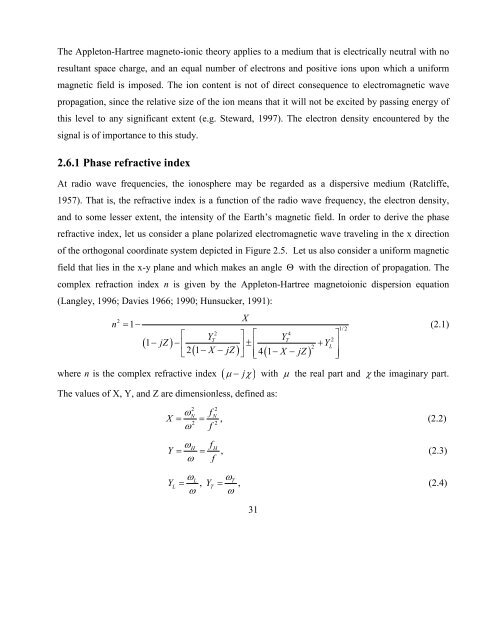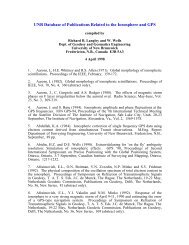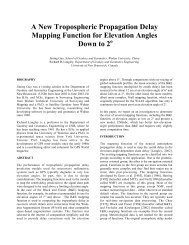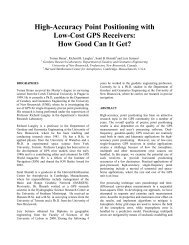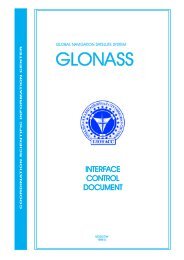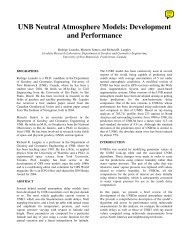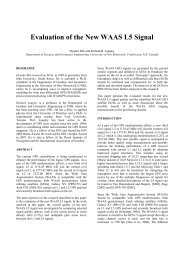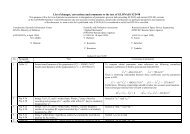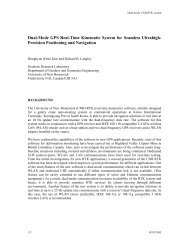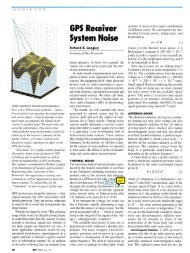solar cycle effects on gnss-derived ionospheric total electron content ...
solar cycle effects on gnss-derived ionospheric total electron content ...
solar cycle effects on gnss-derived ionospheric total electron content ...
You also want an ePaper? Increase the reach of your titles
YUMPU automatically turns print PDFs into web optimized ePapers that Google loves.
The Applet<strong>on</strong>-Hartree magneto-i<strong>on</strong>ic theory applies to a medium that is electrically neutral with noresultant space charge, and an equal number of electr<strong>on</strong>s and positive i<strong>on</strong>s up<strong>on</strong> which a uniformmagnetic field is imposed. The i<strong>on</strong> c<strong>on</strong>tent is not of direct c<strong>on</strong>sequence to electromagnetic wavepropagati<strong>on</strong>, since the relative size of the i<strong>on</strong> means that it will not be excited by passing energy ofthis level to any significant extent (e.g. Steward, 1997). The electr<strong>on</strong> density encountered by thesignal is of importance to this study.2.6.1 Phase refractive indexAt radio wave frequencies, the i<strong>on</strong>osphere may be regarded as a dispersive medium (Ratcliffe,1957). That is, the refractive index is a functi<strong>on</strong> of the radio wave frequency, the electr<strong>on</strong> density,and to some lesser extent, the intensity of the Earth’s magnetic field. In order to derive the phaserefractive index, let us c<strong>on</strong>sider a plane polarized electromagnetic wave traveling in the x directi<strong>on</strong>of the orthog<strong>on</strong>al coordinate system depicted in Figure 2.5. Let us also c<strong>on</strong>sider a uniform magneticfield that lies in the x-y plane and which makes an angle Θ with the directi<strong>on</strong> of propagati<strong>on</strong>. Thecomplex refracti<strong>on</strong> index n is given by the Applet<strong>on</strong>-Hartree magnetoi<strong>on</strong>ic dispersi<strong>on</strong> equati<strong>on</strong>(Langley, 1996; Davies 1966; 1990; Hunsucker, 1991):n2= 1−2 4⎡ Y ⎤ ⎡TY⎤T2− − ⎢⎥ ± ⎢+ Y2 L ⎥⎣ 2( 1− X − jZ ) ⎦ ⎢⎣ 4( 1− X − jZ ) ⎥⎦( 1 jZ )where n is the complex refractive index ( µ jχ)The values of X, Y, and Z are dimensi<strong>on</strong>less, defined as:X1/ 2(2.1)− with µ the real part and χ the imaginary part.XY2 2ωNN= = f ,(2.2)2 2ω fω f H H= = ,(2.3)ω fLTY = ω ωL, YT,ω= ω(2.4)31


